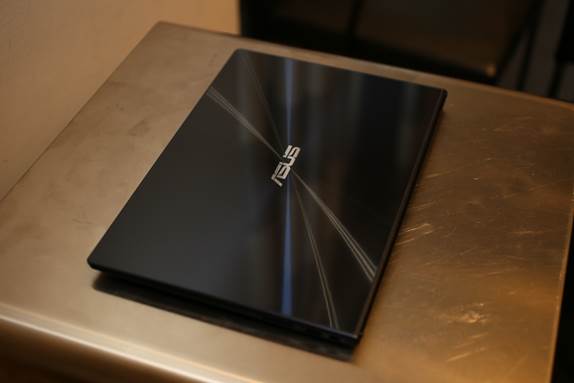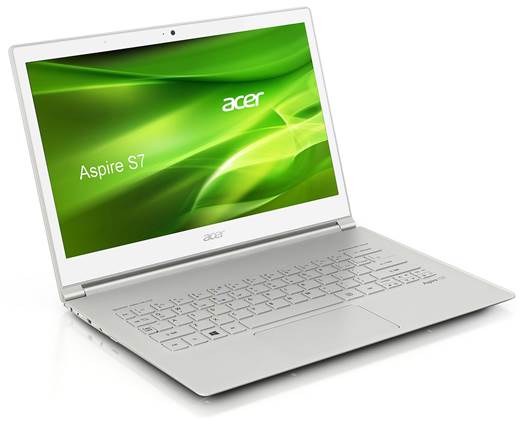Performance
PC Mark 8
PC Mark 8 is a synthetic benchmark that puts the machines
through normal usage scenarios such as web browsing, document writing, video
encoding, photo editing and casual gaming. A good gauge of overall performance
is the Home benchmark, which combines all of the above mentioned tasks.
All of our notebooks have similar components, with an Intel
Core i7 processor, integrated graphics and a fast SSD. The only differences are
Sony's Vaio Pro 13, which has just 4GB RAM, and ASUS Zenbook UX301, which has a
more powerful 2.8 GHz processor and Intel Iris 5100 graphics.

ASUS Zenbook UX301
For the Home benchmark, the Acer Aspire S7 managed to stay
ahead of the ASUS Zenbook UX301, despite the latter having a more powerful CPU
and GPU. This result indicates that the UX301's superior chip doesn't give it
much of an advantage if you're using it as a general purpose machine.
In the Creative Benchmark, which tests the machines'
abilities to encode and edit multimedia, as well as gaming, the Zenbook UX301
CPU starts to perform as expected. It scored 23% better than the Acer Aspire
S7, mostly thanks to its more powerful onboard Intel Iris graphics 5100, which
is responsible for rendering and encoding multimedia.
And as for the Work benchmark, it's the enterprise-friendly
Toshiba Portege Z30 that leads the Ultrabooks. Its no-frills design allows it
to perform best on what's most important for its target audience (browsing and
document editing) while preserving battery life.
3DMark
The Zenbook UX301's Intel Iris graphics 5100 led the way
here, performing 18% better in 3DMark (2013) than the Acer Aspire S7, which had
the best gaming results among our Intel HD 4400 machines. The notebook lagging
behind the rest was again the Sony Vaio Pro 13, which is again handicapped by its
lack of RAM.

Acer Aspire S7
Far Cry 2
The Zenbook UX301's benchmark scores in Far Cry 2 were even
better, outscoring the rest of the machines by almost double. In fact, the
UX301 managed to score almost 40% better frame rates in "very high"
settings, and 30% better in 'medium' settings compared to the Acer Aspire S7.
Battery Life
While the Zenbook UX301 may have the most powerful CPU and
GPU in our shootout, the tradeoff is evident when we look at battery life where
it struggled to last just two and a half hours - by far the worst of all of our
Ultrabooks. The ASUS' battery life was also further affected by its very bright
and high-resolution (2560 x 1440 pixels resolution) display.
Surprisingly, despite its high resolution 3200 x 1800
display, the Lenovo Yoga 2 Pro managed to last over four hours. But it's the
Toshiba Portege Z30 that boasts the best battery life, lasting for over five
hours - although do note that this is probably at least partially due to its
1366 x 768 resolution display.
And the Best Ultrabook
is...
Lenovo Yoga 2 Pro
We love the Yoga 2 Pro for its extremely sharp 3200 x 1800
pixel resolution display and versatile convertible form factor Unlike many
other convertible Ultrabooks, the Yoga 2 Pro's simple hinge-based convertible
design doesn't result in any compromises (like a smaller trackpad or fragile
swivel hinge) for its notebook form factor.

Lenovo Yoga 2 Pro
Performance was also good on the Yoga 2 Pro - even with its
super high-res display, battery life didn't suffer and its Intel HD 4400
integrated graphics had no problem driving its display. Best of all, Lenovo
have managed to keep the Yoga 2 Pro very affordable without cutting back on
build or design quality. It remains slim and lightweight and, while the build
materials are mainly plastic, the finishing definitely looks and feels premium.
Specifications
·
Model: Lenovo Yoga 2 Pro
·
Processor: Intel Core i7-4500U
·
CPU Speed: 1.8GHz
·
Chipset: QM88
·
Operating System: Windows 8.1
·
Display Size: 13.3-inch
·
Multi-touch Display: Yes
·
Display: IPS LED Backlit
·
Brightness: 350 nits
·
Graphics: Intel HD graphics 4400
·
RAM: 8GB
·
Storage: 256GB SSD
·
Connectivity: Wi-Fi (N), Bluetooth 4.0
·
Ports: 1 x USB 3.0, 1 x USB 2.0, micro-HDMI, audio combo
jack, SD Card reader
·
Battery: 54WH
·
Dimensions: 330 x 220 x 15.5mm
·
Weight: 1.39kg
·
Powerbrick Dimensions: 10.5 x 6.5 x 1.8cm
·
Powerbrick Weight: 325g
·
Price (with Intel core i7): $2,099
|